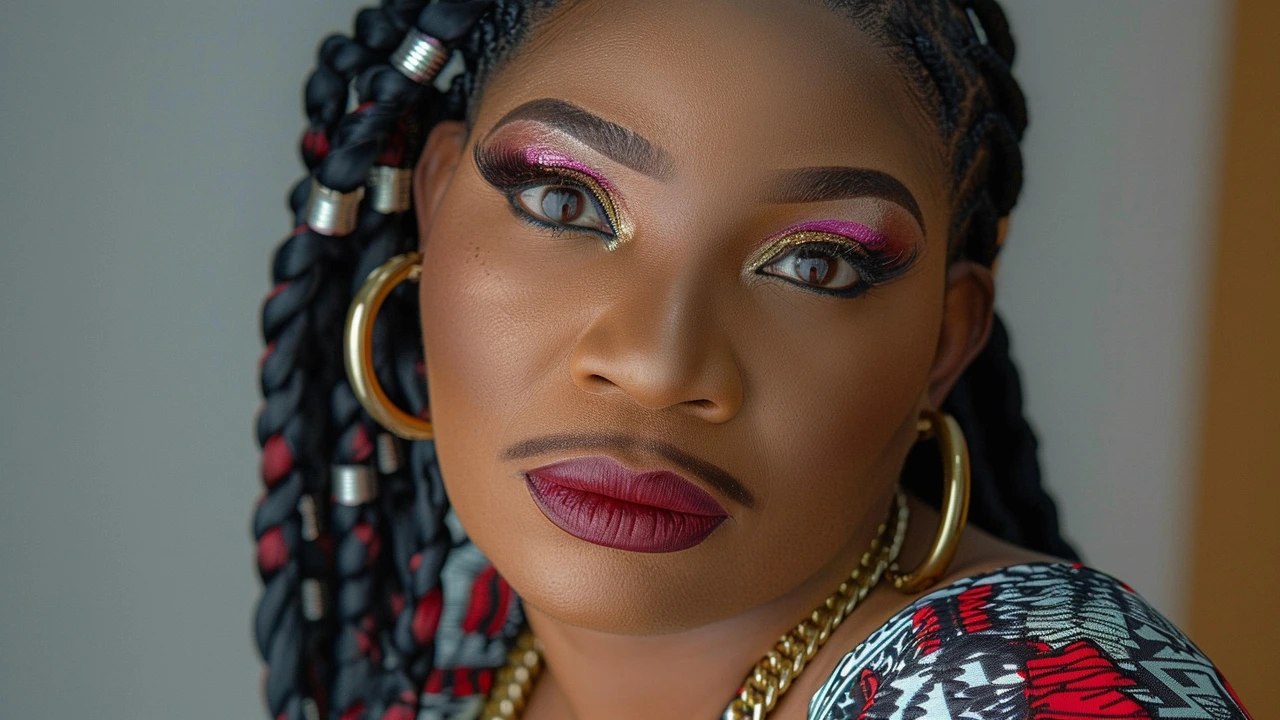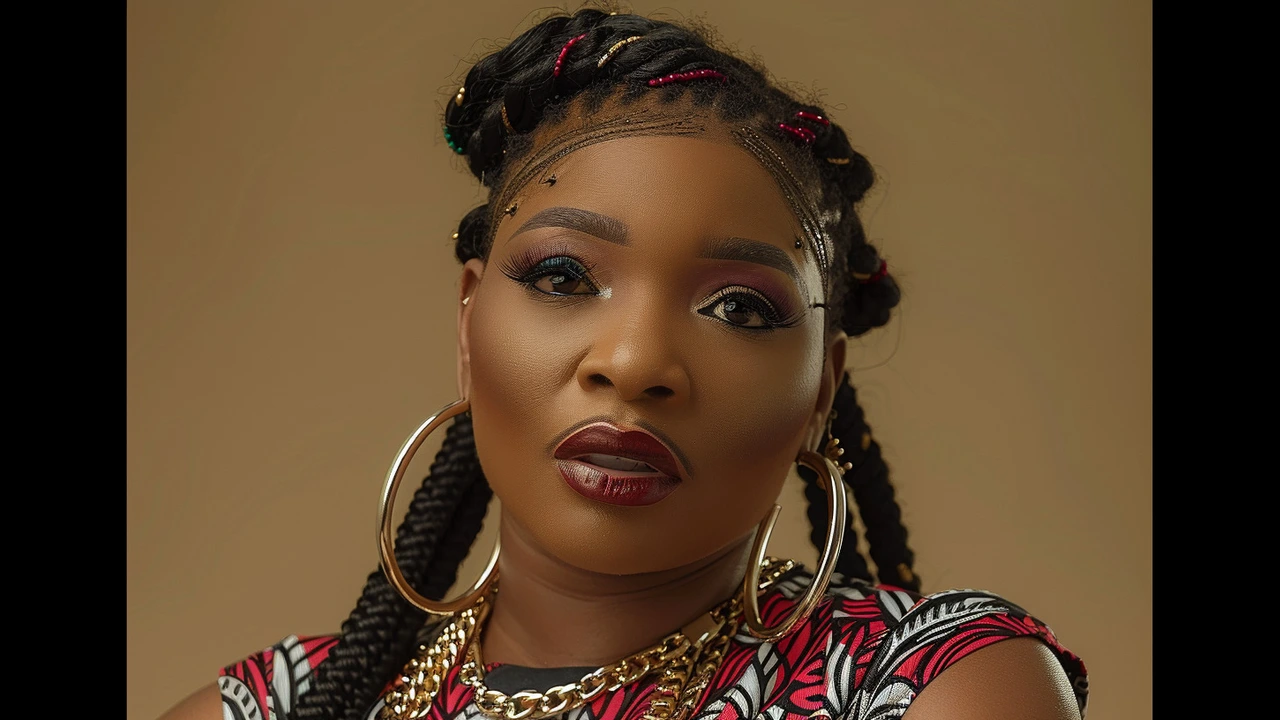Lagos Police Counter Nollywood Star Laide Bakare's Harassment Claims During Traffic Stop
Recent events in Lagos have brought Nollywood actress Laide Bakare into the spotlight, but not for her acting prowess. Instead, her name is making rounds in connection with an alleged harassment incident involving the Lagos State Police Command. Bakare's claims of mistreatment have sparked conversations on social media, drawing varied reactions from her supporters and the general public.
The incident in question took place when Laide Bakare was stopped by Lagos police officers for maneuvering her vehicle into the BRT lane, a restricted area meant solely for Bus Rapid Transit in the city. According to SP Benjamin Hundeyin, the command's spokesperson, this traffic violation prompted the officers to intervene. Instead of cooperating with the officers, Bakare reportedly decided to create a commotion. Her decision to stay outside the vehicle as it was being conveyed to the Lagos Metropolitan Area Transport Authority (LAMATA) office further compounded the situation.
In stark contrast to Bakare's social media posts, which painted a picture of her being forcibly dragged out of the car with her teenage daughter inside, the police maintain that no physical confrontation occurred. The narrative outlined by the police details that Bakare was confronted solely for breaching traffic regulations, and after some back and forth, she was fined N70,000. This amount was reportedly paid into government coffers, concluding the incident from a law enforcement perspective.
Discrepancy in Narratives
The diverging accounts of what transpired have led to public debates, with supporters on both sides convinced by their respective versions of the story. Bakare's initial post spoke to a distressing experience where police, according to her, exhibited unnecessary force. Her words conveyed a mix of frustration and helplessness as she detailed her version of the events.
However, the official response from SP Hundeyin aims to demystify the episode with a factual recount of the proceedings. By stating that no physical interaction occurred, the police are putting forth a narrative that seeks to mitigate claims of brutality or mistreatment. The implication here is that Bakare's decision to put out her account on social media may not have presented the incident in an entirely truthful light.

Public Reactions and The Power of Social Media
The power dynamics between public figures and law enforcement often play out prominently on platforms like Instagram and Twitter, where celebrities have direct access to millions of followers. Bakare's allegations, amplified by her status as a well-known actress, immediately garnered attention, leading to a wave of comments and shares. This public reaction underscores a critical aspect of modern-day incidents involving public figures—the court of public opinion often runs its course long before official narratives are even released.
Several questions have been raised about the veracity of both accounts. Supporters of Bakare have questioned the motivations behind the police's rebuttal, speculating on possible lengths the authorities could go to ensure their side of the story prevails. Conversely, critics have scrutinized Bakare’s rapid recourse to social media, suggesting it might have been an impulsive decision fueled by the stress of the moment rather than a measured recount.
Importance of Fact-Checking
This incident strongly underscores the importance of fact-checking and responsible reporting, especially in an age where information spreads like wildfire. Observers have called for a level-headed approach to the situation, suggesting a thorough investigation to clear any ambiguities. Given the charged nature of celebrity status and law enforcement interactions, it's vital for the larger audience to have access to verified information.
Moreover, such high-profile incidents bring to the fore the imperative need for clearer communication channels between the populace and the police. The disparity in the accounts given by Bakare and the police points to a broader issue of trust and transparency, not just within Nigeria but globally in similar contexts.

Conclusion
As it stands, the police’s response challenges Laide Bakare’s allegations, putting forth an official narrative that diverges significantly from the actress’s account. While Bakare’s supporters stand by her, citing her first-hand experience and public reputation, the police insist that procedural traffic enforcement, devoid of physical altercations, was all that transpired.
In addressing such clashes of narrative, it's crucial for there to be independent verifications where possible, ensuring that both authority figures and public personalities are held to account. Misinformation, whether intentional or unintentional, has the power to erode public trust, making the task of presenting factual recounts all the more paramount.
While this particular incident continues to unfold, the broader takeaways point to the continual need for respectful engagement, both during interactions with law enforcement and across social media platforms. The balance between sharing personal experiences and upholding truth must be navigated carefully, lest the lines blur to the detriment of genuine accountability.


Zac Death
From a calm perspective, the whole traffic stop saga reads like a classic case of two narratives colliding on a public stage. The police say it was a routine enforcement of the BRT lane rule, while the actress paints a picture of overreach. Both sides have valid points to consider, especially when you factor in the pressure of a viral moment. It’s easy to get swept up in the drama without looking at the underlying traffic policy. That lane exists to keep mass transit flowing, and violations can cause real gridlock. At the same time, a public figure’s dignity deserves respectful handling. A balanced conversation would acknowledge the need for law compliance and a humane approach. Hopefully the community can sift through the noise and find a middle ground.
Lizzie Fournier
Honestly, it feels like we’re watching a tug‑of‑war between credibility and perception. On one hand, the police spokesperson gave a concise rundown of the incident, emphasizing that no force was used. On the other, the actress’s post captured a very personal sense of vulnerability that resonates with many followers. In the age of instant sharing, emotions can amplify facts, and facts can sometimes get lost in the swirl. It’s essential to tread carefully, giving space for both institutional explanations and individual experiences. Whether the truth lies somewhere in between or leans toward one side, this conversation reminds us how powerful social platforms have become for shaping public discourse.
JAN SAE
Wow, what a whirlwind-so many perspectives, so many details, and yet the core issue stays the same: an alleged miscommunication in a high‑stress moment! The police narrative, crisp and factual, stresses procedural correctness; meanwhile, the actress’s account, raw and emotive, highlights personal impact! Both sides are certainly feeling the heat of public scrutiny, and both are trying to protect their image, reputation, and credibility! In such scenarios, the court of public opinion often jumps the gun, forming conclusions before all evidence is examined! It’s crucial to step back, let investigations run their course, and keep an eye on how narratives evolve over time! Ultimately, clarity will emerge from thorough fact‑checking and balanced reporting!
Steve Dunkerley
Analyzing the procedural aspects of this incident reveals several layers of operational protocol that merit closer examination. The Lagos State Traffic Regulation mandates strict adherence to BRT lane usage to maintain throughput efficiency, and violations trigger automatic enforcement mechanisms. Standard operating procedures dictate that officers issue a citation, assess a fine, and, if necessary, repossess the vehicle for record‑keeping. In this case, the issuance of a N70,000 fine aligns with the stipulated penalty bracket for unauthorized lane intrusion. Moreover, the procedural logs should reflect a timestamped sequence of events, including the officer's verbal warnings and the driver's compliance status. The narrative presented by the police spokesperson suggests that no physical force was employed, which is consistent with the absence of any documented use‑of‑force report. Conversely, the actress's depiction of being forcibly removed implies a deviation from the established protocol, potentially indicating a miscommunication or a perceived escalation. It is also worth noting that the presence of a minor in the vehicle adds a heightened duty of care obligation for the officers, obligating them to ensure the child’s safety throughout the interaction. The subsequent transport of the vehicle to LAMATA for administrative processing is a standard follow‑up for traffic infractions involving specialized lanes. However, without access to the official incident report, it remains challenging to reconcile the divergent accounts fully. Therefore, an impartial forensic audit of the CCTV footage, officer statements, and the driver's testimony would be instrumental in establishing an objective factual baseline. Such an audit would also illuminate any procedural gaps that could be addressed through policy refinement or additional officer training. In sum, while the fine and procedural steps appear to conform to regulatory expectations, the dispute hinges on the perception of force, a variable that necessitates empirical verification to resolve conclusively.
Jasmine Hinds
Crazy stuff 🙃🏼 the whole thing blew up fast and people are just throwing opinions everywhere. It's wild how a single traffic stop can turn into a massive debate online! Stay cool everyone.
Madison Neal
From an empathetic standpoint, the clash of narratives underscores how personal perception intertwines with institutional protocols. The actress’s emotional recount resonates with many who have felt vulnerable in authority encounters, while the police’s procedural clarity provides a structural counterbalance. Both discourses contribute valuable data points for a comprehensive analysis of law‑public interaction dynamics. It would be constructive for future engagements to incorporate de‑escalation training and transparent communication channels, ensuring that dignity and compliance coexist.
John Crulz
Looking at this through an open‑minded lens, it’s evident that high‑profile incidents can amplify underlying systemic issues. The traffic violation itself is straightforward, yet the escalation hints at a gap in mutual understanding. When public figures voice personal grievances, their platforms magnify the narrative, which can pressure institutions to respond swiftly. Conversely, official statements aim to preserve procedural integrity, sometimes appearing detached from lived experience. This tension highlights the need for ongoing dialogue between law enforcement and community members, especially those with substantial reach. Bridging that gap could foster trust and reduce the likelihood of similar flashpoints in the future.
Anita Drake
Adding to that perspective, cultural nuance plays a significant role in how such events are interpreted across different audiences. While some may view the police response as routine, others perceive it through the lens of broader societal narratives. Recognizing these layers helps foster a more balanced conversation.
Eduardo Lopez
Frankly, the melodrama surrounding this episode is a textbook example of how celebrity culture hijacks legitimate public safety discussions. The spotlight shines so brightly on the actress’s emotional outcry that the fundamental traffic law-intended to keep the BRT system efficient-gets lost in the theatrics. It’s essential to separate the performative spectacle from the sober reality of jurisdictional enforcement. When the narrative is reduced to sensational headlines, we risk eroding respect for the very frameworks that maintain order. Let’s refocus on the procedural facts and avoid indulging in needless sensationalism.
Nancy Perez de Lezama
The incident underscores the importance of clear communication between authorities and citizens.